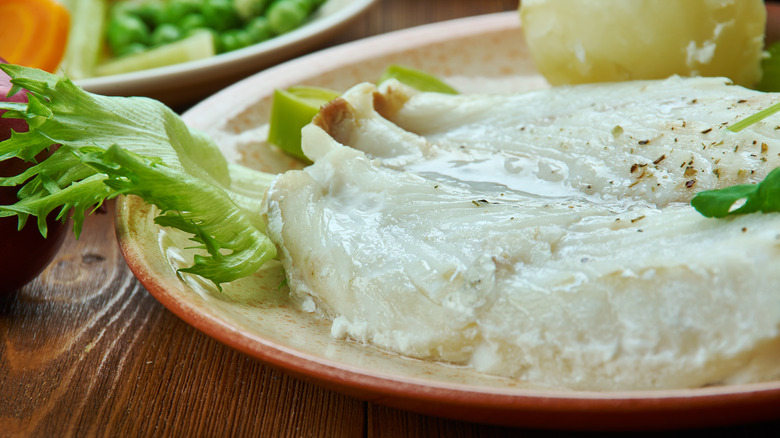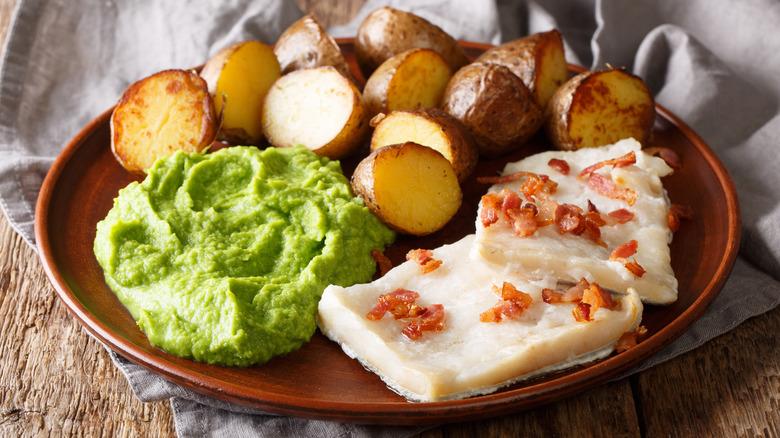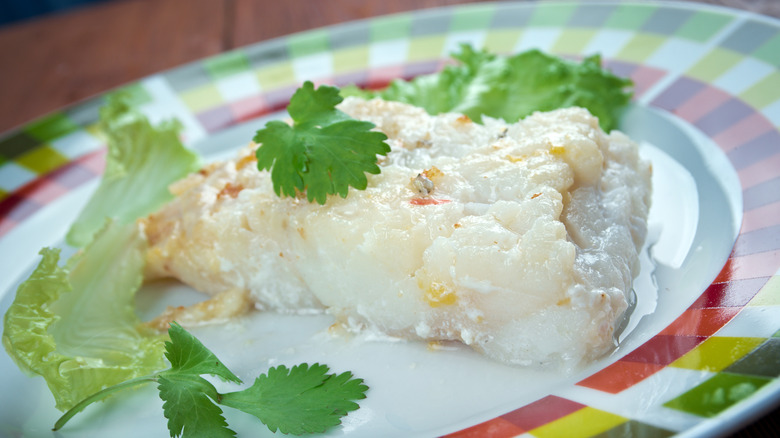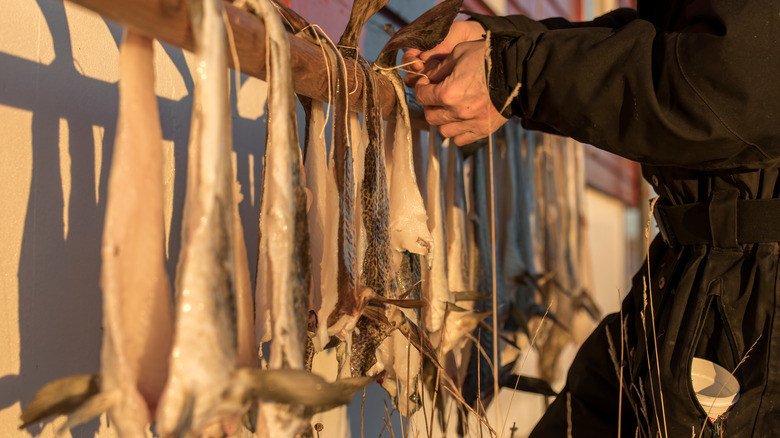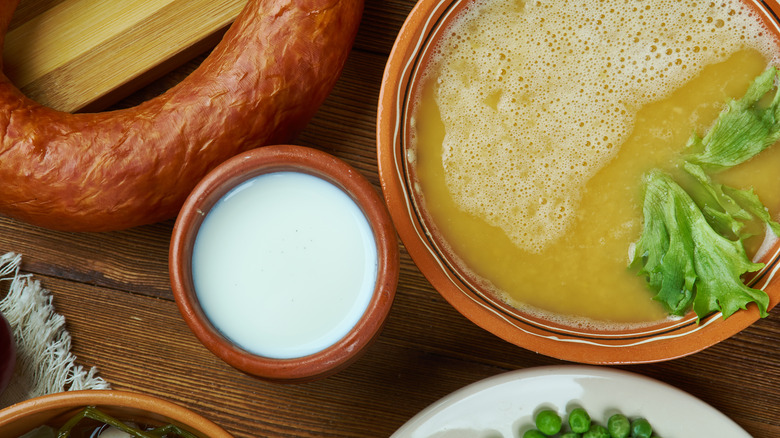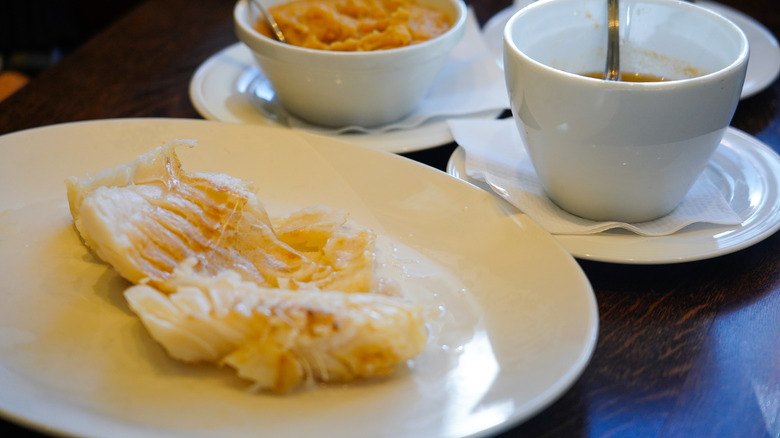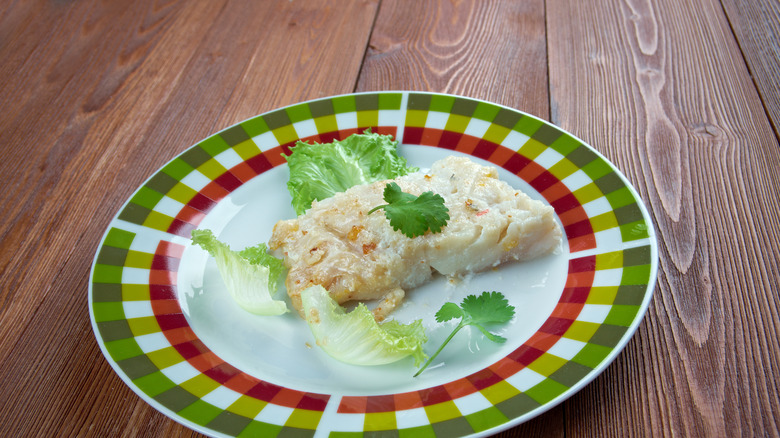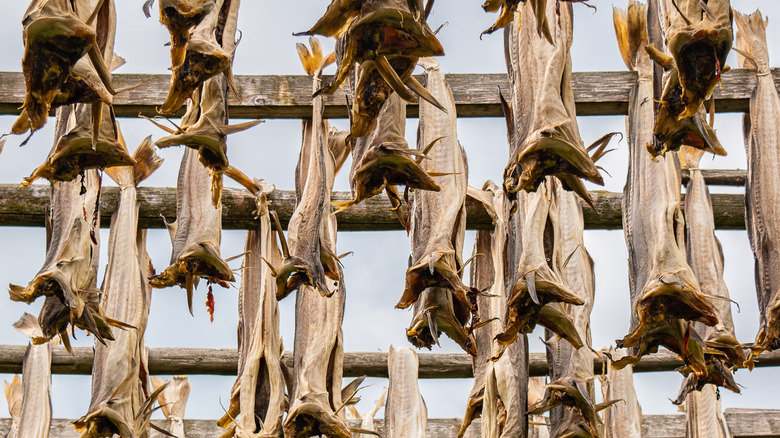What Is Lutefisk And What Does It Taste Like?
With a distinctive odor and gelatinous texture, lutefisk is definitely an acquired taste. Unlike salmon and tuna, you can't actually go out fishing for lutefisk, because it's not a specific fish itself; rather, it's a form of whitefish (traditionally cod) that is air dried until hard. Then, the fish is softened by soaking it in water and lye before consuming.
The word lutefisk itself translates roughly to "lye fish," says Smithsonian Magazine. Considered peasant food, this method was used to preserve any leftover fish that wasn't sold or cooked. While it originated in Scandinavia (particularly Sweden and Norway), lutefisk has fallen out of favor there and is not considered especially popular in the "old country." However, some Scandinavian Americans eat lutefisk regularly, and it is now eaten more frequently in the United States than in all of Scandinavia combined.
If you're interested in trying this divisive dish, there are a few things you should know (like how you eat it and where it is even sold) before taking the plunge.
The origin of lutefisk
Some of lutefisk's notoriety stems from its mythological origin story. According to Smithsonian Magazine, one long-standing legend retells how St. Patrick attempted to poison Vikings who invaded Ireland with fish soaked in lye. The Vikings, according to the myth, enjoyed the taste of the fish so much that they adopted it as part of their diet. While the story sounds appealing, it most likely never occurred, as the Viking invasion of Ireland happened quite a long time after St. Patrick's death.
The Canora Courier reports some believe lutefisk actually originated when Vikings burned down villages with racks of drying fish, while others claim it was invented when someone dropped a fish in the ashes of a fire and were too poor to throw it away, so they ate it anyway. Both stories seem a little, well, fishy.
So what is the true origin of lutefisk? It's a little murky. One scholar posits in The Norwegian American that the invention of lutefisk potentially stems back to an era before Vikings even existed. They share one possible reason people began using this method is that (by soaking the dried fish in a lye solution) the seafood expands in size beyond that of a standard fish, allowing the food to go that much further. Additionally, a lye soak breaks down the protein in the fish and makes the final product much more digestible and nutritious. While those old Norwegians likely wouldn't have known about the nutritional benefits of eating lutefisk from a scientific standpoint, the outlet explains they would have been able to tell that they felt fuller and invigorated after eating the dish.
Lutefisk has a unique texture
Lutefisk's gelatinous texture is a result of the fish breaking down during the preparation process. First, the fish are cleaned and then hung to dry, which An Off Grid Life notes takes approximately nine to 10 days. When fully dried, the cod will be tough and leathery. The process of rehydrating the fish takes over a week, explains CDKitchen. For five to six days it's soaked in cold water, with the water being changed every day. Next, it's soaked in a combination of lye and water for another week, and then soaked in cool water, changed daily, again for another few days. This soaking and rinsing breaks down the protein in the fish, giving lutefisk its notorious jelly-like consistency.
If lutefisk is cooked correctly, it can be flaky and tasty. But in the wrong hands, it turns to mush, with some people saying it resembles "snot" or a fishy Jell-O. One person on Quora who shared they regularly ate lutefisk at Christmas growing up, described it as, "Very mild but its texture is a bit unattractive in the modern taste. It's like jelly."
Lutefisk has a distinct smell
Perhaps the greatest offense of the lutefisk isn't necessarily its texture, but the smell associated with it. Most people describe it as a very pungent, fishy smell that can't be easily forgotten. Simply put, lutefisk smells strongly of fish, with notes of sourness and ammonia. The smell does tend to recede after the lutefisk has been cooked, though some don't make it that far.
Lutefisk's smell is so strong it has a lot of detractors. Poke around the internet and you'll find plenty of jokes referring to it. Sun Sentinel shares: "'What's this fly doing in my lutefisk?' 'Gagging,' said the waiter."
Author Garrison Keillor summed up its odor as powerful enough to "gag a goat" (via NPR), and the TV comedy "King of the Hill" noted, eat enough of it and you may soon be known as "the man with the terrible smell" (via YouTube). The Canora Courier shares that acclaimed food writer Jeffrey Steingarten (known as "the man who ate everything") once called lutefisk, "A weapon of mass destruction," opining that, "Lutefisk is the Norwegians' attempt at conquering the world. When they discovered that Viking raids didn't produce world supremacy, they invented a meal so terrifying, so cruel, that they could scare people to become one's subordinates."
The real bonus that comes from the smell? As one person told AP News, "One thing about eating lutefisk. You can wear dirty socks and nobody'll even notice.″
Lutefisk's taste is definitely something else
Generally speaking, people say lutefisk tastes mildly fishy, with a soapy aftertaste and a hint of ammonia on the palate, though there seems to be a lot of variation of its description based on whether people are fans of the stuff or not. A few different factors can affect lutefisk's taste as well, including what fish was used — Norwegian cod has a stronger smell and taste compared to other whitefish — and whether it was made with lye or with birch ash, which can give it a milder flavor. Many makers have also switched from lye to caustic soda, the Sun Sentinel reports, which is just another form of sodium hydroxide.
Wisconsin lutefisk-eating champion, Jerry Osteraas told The Post Bulletin, "I've always said it tastes like lobster when you put a little butter on it, but there isn't any sweetness to it." Clearly, Osteraas can be considered a lutefisk fan.
But to many, it's just a vehicle for what it's served with. One fan who organizes a lutefisk dinner at their church told Twin Cities Pioneer Press, "It's kind of a fishy taste, but for me, it's the butter and the cream sauce I eat it with."
How to eat lutefisk
Lutefisk comes in several forms and the way you eat it depends on the cooking preparation. Often, the fish is boiled or baked, and served with butter or cream sauce. Sometimes, it is served with bacon fat on top and eaten with other traditional Scandinavian fare like boiled potatoes, peas, meatballs, or lefse, a soft Norwegian potato flatbread.
According to a review by SW News Media, boiled lutefisk is usually finished off with butter, salt, and pepper — and get prepared to slurp. This cooking method results in a near-liquid final product. The outlet describes baked lutefisk as akin to eating "warm, fish-flavored Jello with a couple of tiny fish bones." Though this may seem less appealing than quickly slurping it down, Northern Wilds shares that baked lutefisk has a less intense smell than other preparations.
If neither baked nor boiled lutefisk sound particularly enticing, you can always search out fried lutefisk. While this might not be the most traditional preparation, SW News Media describes it at the most palatable cooking method.
Want to try lutefisk?
If after all that it's still appealing to you, lutefisk can usually be found in church dinners and Scandinavian heritage events throughout the country, particularly in the upper Midwest, which is sometimes referred to colloquially as the "Lutefisk Belt" (via NPR). In Madison, Minnesota (the self-titled "Lutefisk capital of the world," as Atlas Obscura reports) there is a huge fiberglass statue of "Lou T. Fisk" that greets visitors as they enter the town. In the Pacific Northwest, local Scandinavian organizations offer lutefisk-eating events throughout the year.
You'll also usually be able to find lutefisk in towns nationwide where there are high populations of Scandinavian Americans — like Poulsbo, Washington, where the Slippery Pig Brewery offers lutefisk tacos on its regular menu.
The Olsen Fish Company boasts to be one of the primary suppliers of lutefisk in the United States, but specialty stores like Walleye Direct and Willy's Products Scandinavian Food Store also offer frozen lutefisk for sale, shipped directly to you.
There are a surprising amount of Lutefisk eating-contests
According to Explore Minnesota, the city of Madison hosts an annual Norsefest that includes a lutefisk-eating contest.
In addition to being able to find lutefisk on the regular menu at places like the Slippery Pig, Poulsbo, Washington hosts Viking Fest. According to the event website, this festival hosts a lutefisk-eating contest. (If you're interested in participating, it's important to know entry costs $15 and you must be at least 18 years old.)
Ballard, Washington holds a lutefisk eating competition that has contestants drink liquid lutefisk straight from a bowl, per My Ballard. In 2008, contest winner Einer Johannsen drank two pounds of the fish in only seven seconds.
These competitions have also spawned local rivalries. The Kitsap Daily News documented an ongoing rivalry between regional lutefisk eating champions, including a tense showdown where three lutefisk fans ate over three pounds of the fish each, with the winner ultimately consuming four pounds of the stuff.
If you're interested in joining in on the lutefisk fun (or maybe just watching), organizations like the Daughters of Norway and Sons of Norway often share details of various lutefisk events in the U.S.
Is lutefisk nutritious?
Along with preserving the leftover fish for the long Norwegian winters, there are other benefits to lutefisk's drying process, Norwegian American notes. Because it's dried there's no longer any moisture that would allow bacteria or mold to grow and ruin the fish. The lye used also breaks down the fish's protein, turning it into amino acids, a process that the stomach usually has to do, making lutefisk easily digestible.
Dried fish is known to be a good source of nutrients like iodine, zinc, copper, selenium, and calcium, shares Food Reviews International, and contains healthy fats. However, it's not all good. As Post Bulletin reports, when you preserve fish, whether by drying or salting, it decreases the nutritional value. Science Daily notes that preserving fish specifically decreases the amount of heart-healthy Omega-3 fatty acids when compared to baked or boiled.
From a purely caloric perspective, lutefisk is relatively lean, with approximately 50 calories in each 100 gram portion (via How Many Carbs). Of course that depends on what you eat with your lutefisk, as some of the recipes mentioned above (like deep fried or smothered in cream sauce) wouldn't exactly be considered health food.
